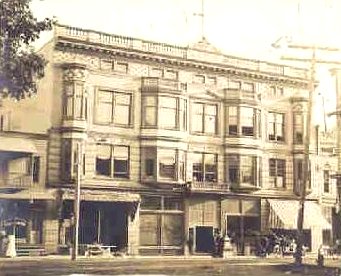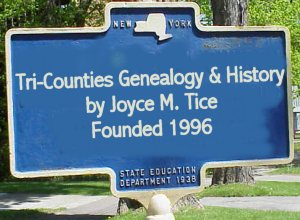
|
Tri-Counties Genealogy &
History by Joyce M. Tice
Tri-County Communities
|
 |
|
Bradford County PA
|
Chemung County NY
|
Tioga County PA
|
| Canton 1849, Canton, Bradford
County PA |
|

Lewis Block, Canton, 1905 |
| Article - Canton 1849 |
| Township: Canton Borough, Bradford County
PA |
|
| Year: |
| Postcard from Joyce's Collection |
| Article Copied by Eleanor Keagle submitted
by Don Stanton |
|
|
|
Joyce's Search Tip - November 2008
 |
Do You Know that you can search just the
articles on the site by using the Articles button in the Partitioned
search engine at the bottom of the Current
What's New Page? |
|
|
CANTON 1849
In the summer of 1849 Fred Black, his wife and son William, arrived
at the Red Tavern by stagecoach. There was not a vacant house in Canton,
so he made his home with the Turner family. In September, he succeeded
in renting a one room house on Troy Street. In this room he conducted his
business as a tailor and used it for living quarters.
The only stores in town were kept by Newman Bros. and Mr. Rathbone.
Mr. Black went to Newman’s store and asked for a bag of flour. Mr. Newman
was astonished at the request. "We don’t keep flour," he replied; "you
must get some wheat and take it to the grist mill." He then directed him
to Mr. Rathbone’s place, where he purchased some wheat, loaded it in a
wheelbarrow and had it converted into flour at what is now Rockwell’s Mill.
A day or two later, Mr. Black wanted some meat and asked for it at Newman’s
general store. He was told they didn’t keep meat for sale, but there was
a chunk in the back room he might have. Mr. Black examined it and said
he would take three pounds. They refused to cut it, but said he might have
the whole piece for three cents a pound and he bought it. The chunk weighed
50 pounds and he had no ice, not even a cellar, so his only way of keeping
it fresh for a few days was tying it to a rope and lowering down a well
almost to the water line. A good sheep could be purchased for 75 cents
at that time.
Mr. Black and the entire neighborhood had to get drinking water from
a well in front of the present residence of Lynn Thomas. Water for other
purposes was brought from the creek on wheelbarrows or stone boats.
He found plenty of work but little or no money as everything was bartered.
Making his first suit of clothes, he received $5.00 paid by 20 bushels
of apples at 25 cents a bushel. Sometimes he would get his pay in wood,
meat, vegetables and store orders. There was very little inconvenience
in this method as there was little use for money. A large part of his business
was cutting of garments to be made at home of cloth made at Hazleton’s
mill across the creek. Dress suits required black broadcloth coats and
trousers with satin vests. Travelling peddlers supplied these goods. The
women made their own dresses and wore starched sunbonnets, the styles in
millinery underwent few changes.
It was no uncommon thing for a young man to hire out to a farmer in
the spring and receive in the fall a cow or colt for his seasons wages.
Real estate was cheap too. When Asa and Stephen Bullock built a harness
shop on the present site of Charles Crawford’s house and the Rialto Theater,
they paid $40.00 for the lot. The adjoining lot now occupied by the Morse
Funeral Home, with 75 feet frontage and extending to Main creek sold at
the same time for $75.00. Then came the railroad in 1854 and a boom in
prices. Mr. Kingsbury of Towanda bought a tract of land and laid out streets.
Center Street lots jumped to $125.00 in quick time.
Samuel Owen and William Tabor owned adjoining farms near Minnequa Avenue,
formerly called Division Street because each gave a portion of land required
for the opening of a street. The first house built on the street is now
the residence of Mr. Reed and was occupied by a colored man, Johnny and
Mary Ann Robinson. Other tracts of land were purchased and other streets
laid out on paper when the railroad boom came, but some did not result
in financial success. Samuel Owen purchased the greater portion of land
lying south of Main Street for $1,500.00 and lived to dispose of $10,000
worth of lots. Charles Stockwell paid $1500.00 for the lands north of Main
Street
and also realized handsomely on the transaction.
The above copied from a hand written manuscript by an unknown writer
- Eleanor P. Keagle (1896-1971)
Did You Know?
Canton Independent-Sentinel 125th Anniversary Issue, May 25, 1989
A Red School House once stood on the corner of Center and Main Streets
A barn and stable for stage horses was at one time at the corner of
Troy and Main Streets
The underground railroad was located on Carson Street where the home
of Mr. and Mrs. Howard Jones now stands.
Henry Ford and Thomas Edison were seen sitting at the Packard Hotel
while making an overnight stop in Canton.
The Liberty Bell passed through town on a railroad car enroute to Buffalo,
NY.
The first school in Canton was in Parson’s log house on Troy St., south
of Mill Creek.
Citizens Hall Theatre once occupied the Trippe Building- present site
of the Ben Franklin.
David Grantier’s water powered mill once operated on Lycoming Street
near Tannery Creek.
Canton once had a “gold mine” on Mill Creek, run by B. Davison and worked
by “Banty” Brown. The mine was known as the “Banty Sam.”
Robert Northrup was the first Cantonian to leave for World War I.
Ernest Bailey was the first Cantonian to be drafted for World War II.
|
Bradford County PA
|
Chemung County NY
|
Tioga County PA
|
|

Published On Tri-Counties Site On ?
By Joyce M. Tice
Email:
Joyce M. Tice
You are the
visitor since the counter was installed on 12 MAY 2005 |
 |
|
